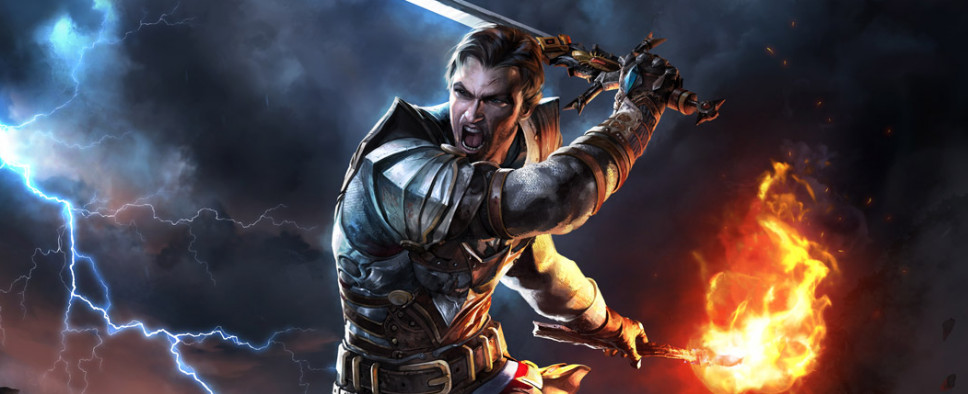Risen 3: Titan Lords Review
-
Category: ReviewsHits: 19932

Article Index
That said, despite a squandered promise and crude dialogue, I enjoyed Risen 3's main quest, and that's largely because Piranha Bytes seemed to better understand its strengths this time around, and crafted a globe-trotting adventure that strongly encourages exploration. Despite not abandoning Risen 2's piracy theme (which proved fairly controversial with the community, but I personally really enjoyed), the game offers more varied and memorable environments in addition to some recycled and slightly retooled locations from Risen 2. The bulk of the game takes place on three islands: Kila, inhabited by some pirates and by a tribe of natives who have been abandoned by their mysterious "Oracle"; Taranis, an island with curious climatic conditions on which the mages are conducting experiments under protection of the Guardians; and Calador, the home of the ancient Demon Hunters, called to arms by the druid Eldric (another returning face, this time from the original Risen), who re-lit the ancient green fire beacons.
The three islands share some structural similarities (all three house a faction with headquarters in the hinterlands of the island, all three have a community of common people in the vicinity of the beach on which you land, and finally, all three have zones that can't be explored until you (unlock) them in the main quest). However, despite that, they feel very distinct. Each of the islands has its own visual theme and well developed history, which influence all the interactions that take place on it, from small-time delivery jobs to quest arcs that tie into the main quest. The best part is that you can visit all of them from the beginning of the game, as the protagonist gets access to a sloop immediately after the heavily scripted, clumsy cinematic tutorial.
However, the actual game and main quest line is far less constricting and reliant on scripts. I spent my first 15-20 hours of the game just jumping from island to island, doing quests and accomplishing objectives while trying to decide which faction I would join. I was pleasantly surprised to discover that I could already solve plenty of quests that were tied to the main quest simply by taking the initiative. In some ways, Risen 3 really feels like the most open title in the series: Where Risen 1 had a really linear ending chapter, and Risen 2 took far too long to open up, Piranha Bytes' third game finally gets it right.
I already mentioned that the game reintroduces factions. For the most part, it's the same three faction setup Piranha Bytes used in most of its titles: At a certain point of the story you're asked to join one of three factions, and depending on which you choose, new quests, abilities and equipment are unlocked, and even the character's appearance is altered slightly. For my full playthrough I joined the Demon Hunters, which meant my character gained a short-range teleport ability instead of the normal dodge and could learn rune magic from the teachers around the Citadel. Just as you might expect from a Piranha Bytes' game, it's possible to rise through the factions' ranks by completing quests, and with each rank comes a more powerful tier of faction armor. Unfortunately, despite all that, I can't help but be slightly disappointed with the implementation of factions in the game. They feel artificial, and not as well-integrated as they were in the past. The main quest requires you to join one faction but doesn't really explain why it's necessary, and there is little to no interplay between them. While in the original Risen choosing a faction felt like a real commitment, in Risen 3 it feels more like a flavor choice, and has very little effect on the main quest.
In general, consequences of your choices are pretty rare in the game. At the beginning of the game I was given the chance to betray one of the possible companions, and chose not to because I was trying to play a good guy. Much to my disappointment, I later discovered the companion was necessary for some plot sequences and would have survived anyway. Minor conundrums have multiple solutions, as usual, and your alignment can convince some companions to leave you, but that's really all there is to it. That said, quest design tends to be pretty decent, with a mixture of simple and more elaborate quests, which often offer multiple options. Sometimes, simply exploring the environments can lead to a memorable situation and a new quest, whether it's a particularly stupid pirate deciding to tag along and bother you constantly with tales of a hidden temple, or what appears to be a skeleton asking for your help after a fight. There are a lot of quests in the game. Frankly, there are too many. I enjoyed most opportunities to explore I was given, even if they came in the form of a fetch quest, but by the end of the game I had grown a bit tired of the familiar rhythm that had been established, and ended up skipping most side content and just going for the finish line.

